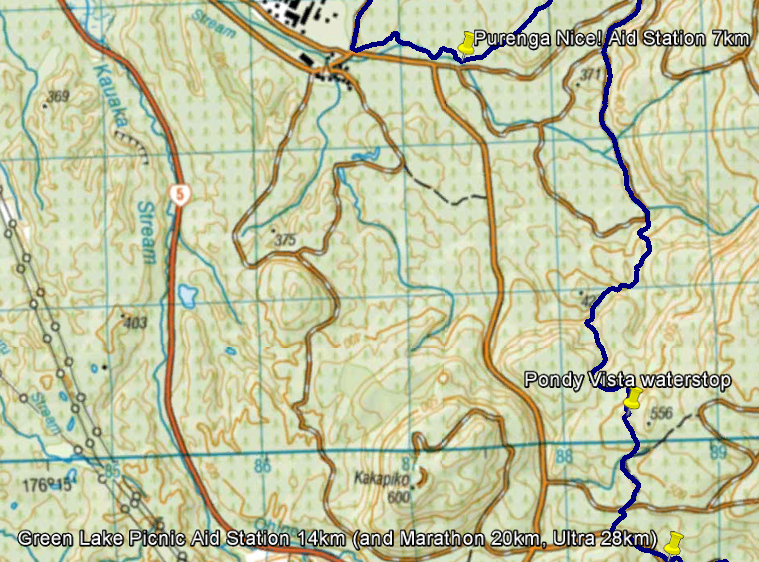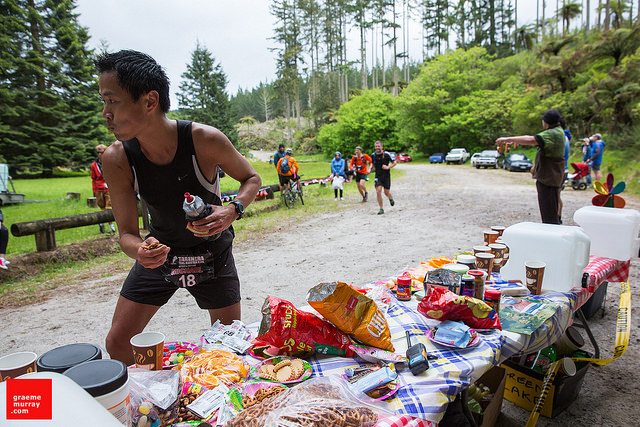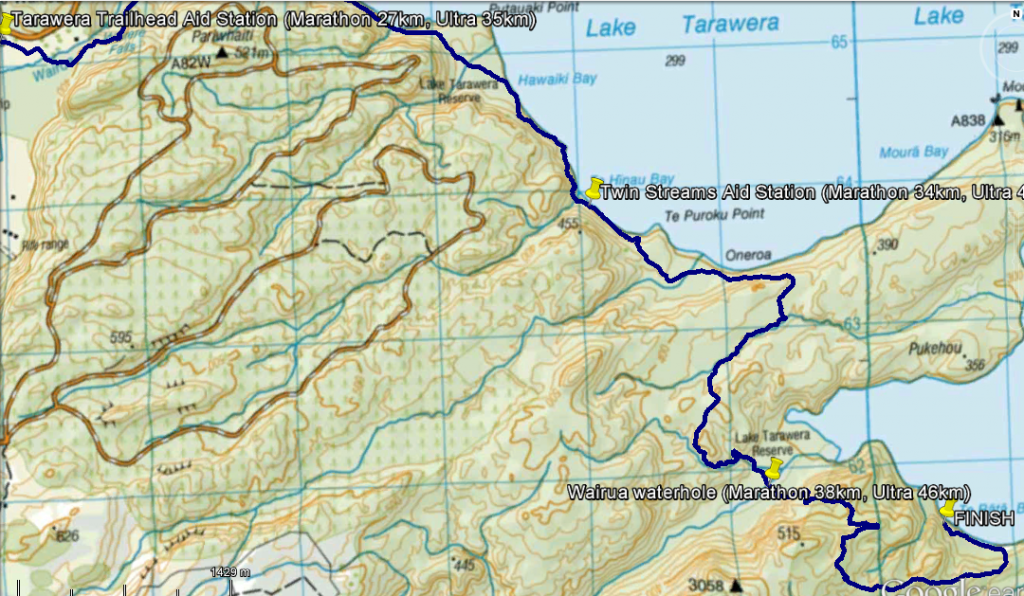Be sure to check out futher images and course detail by clicking on the above widget by TrailRunProject, NZs largest and most complete trail run directory (it’s free!).
Oct 2016 – The Revised edition! (we must stop going on meeting like this…)
Anyone that is still surprised by something unexpected on race day has clearly never met Tim and Paul. What we know for certain is that every single year – without fail – some new devilry has been compounded into the event. Be it a surprise river crossing or a hilarious set of stairs that takes you back to the exact same spot you were 5 minutes earlier, we have to assume that Timothy Day has engineered one more adventure for you in 2016.
Hey team, a lot of people have been asking for advice on how best to get through the Tarawera Marathon and 50km (TM50).
In any trail run there are two approaches.
- Complete
- Compete
Depending on your intention the run can take two different forms.
How to Complete the TM50
For many, the day is really just about ‘getting through’ so it’s a matter of knowing that you’re capable of doing it, believing in yourself and persisting with resolute resolve to see it through. Take your time, have fun and get it done. Avoid cut-offs and know where they are and when. Never ride them, rather give yourself a good buffer to allow you that 10-15min you might take at an aid station or if you have to stop somewhere unintentionally (toilet etc). Have a plan and don’t rely on me to write it for you. Know the course and what to expect.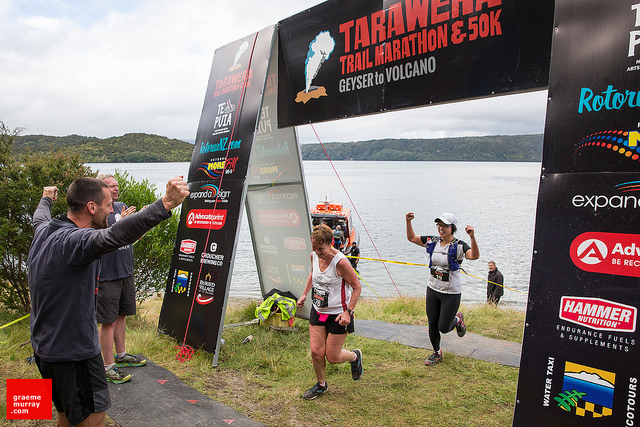
Your intensity will be low since you’re not pushing yourself. As such your ‘burn rate’ wont be too high and food/fuel/fluids should go in easy enough and not be lost at any significant rate. You will be out there for a long time so think about all the things you might need. Lubricant, Sunblock etc.
Walk anything you wouldn’t run in training. There are only a handful of serious climbs but if you want to ensure you’ll get through, walk every ascent, run every descent, and walk/jog anything that’s flat. That strategy alone will have you well ahead of cut-off.
How to Compete the TM50
A lot of people will say that they want to ‘have a good run’ or ask about what they should be doing for this race in order to do well. This is either an overt or latent desire to actually push oneself and see what is possible. This is an intent to race. Not necessarily for a win or podium, but to challenge yourself and run to the best of your fitness. Whether it be against others or yourself, you’re here to compete!
Can we just be clear that TM50 isn’t a serious-pants race and in general the event directors don’t make a big deal about seriously celebrating athletic achievement here. It’s great to see people push themselves and run fast but you wont see TM50 on the UTWT world tour and it’s unlikely you will bump into Killian or Sage on the trails.
Regardless if it’s the marathon or the 50km you’re targeting you’ll need to get one thing spot on – PACING.
Knowing what intensity is right at any moment in the run is the difference between getting the best out of yourself and putting yourself out of the race.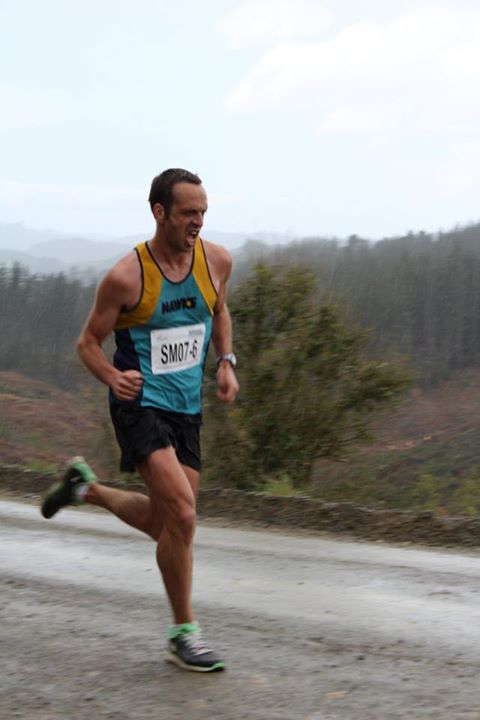
For all intents and purposes the 42km and 50km are effectively the same in terms of effort with only about 5-10s per/km different in your target speed. But what is target speed?
There are a few ways we can work this out but you have to remember that as terrain and conditions vary it’s best to understand your pace as an intensity. Not actual speed. Sadly, unless you want to spend the day in your Heart Rate Monitor you’ll struggle to accurately measure intensity without a deep understanding of what certain paces ‘feel’ like.
For the 42/50 the HR you would want to maintain is around 81%-84%maxHR. NB – allow at least 10min for this to ‘settle’.
Since most will be running with a GPS watch, a great way to establish your correct race pace without a HRM is to know what speed you should be doing on the flat and maintain that intensity at all times. If your target race pace is 5min/km you should check your watch on the flat forestry roads and ensure you are holding flat-5s then ask yourself how that feels. Then when you’re in a section of trail or undulation you should ignore the pace and ensure you still ‘feel’ the same as you did when you were on the flat running 5:00min/km.
How to calculate your target race pace
<snip>
I’m removing this section for 2016. Stop taking yourself so seriously!
FUEL
After the first hour you should consider fuelling yourself. Roughly every 45 minutes put some fuel in – depending on how hard you are pushing. Ideally rotate Gel, Gel, Solid. Make your solid around 1/2 an energy bar (Cliff etc).
TM50 is a long distance eating competition so unless you’re there to throw down, just skip your way from aid-station to aid-station. Your primary goal should be to get to the buried village before I’ve eaten all the scones.
If you’re going to use gels (oh look, it’s captain serious-pants over here) use quality gels and avoid stimulants.
Know the difference between a stimulant and a fuel. Caffeine is a stimulant, not a fuel. Red Bull is full of stimulants. It also has fuels (low quality) but that which makes you feel alive isn’t fuel, it’s stimulant. Stimulants are often diuretics so save them for late in your race.
Your body will access GLUCOSE easiest. Don’t make your digestive organs work to access your sugars. Don’t complicate your sugars. Sucrose (white sugar, candy etc) is hard to get to. Fructose (fruit sugars) can also be difficult to access and typically comes with fibrous plant material that may put you in the bushes more than you want (jungle poo!).
Electrolytes plus (maybe) a little salt. Little and often. Easiest with fluids.
Watch out for things you don’t need that may have a negative effect. Most ‘fuels’ come laden with a cocktail of ingredients. The ones you actually need are on a short list. More is not more. eg Magnesium can cause upset stomachs or diarrhea. Is the claimed benefit of special ingredient-x worth the risk? My trick is to use a few different quality products to avoid overdosing on any one thing that they may have stuck in there because – science?
Nothing new on race day – unless you are treating TM50 as a long training race for TuM in Feb, don’t drastically change what you already know works for you unless what you have been doing is horribly horribly wrong.
Start easy, finish hard (giggity)
Negative split your run by effort. You’ll need to know what your total fitness is and consider how you’re going to split it to apply it evenly over the entire run. Do this by getting through the first half comfortable then gradually increase your discomfort until you have spent everything by the time you arrive at the finish. What you should find is that your target pace felt easy early in the day, then by the end, screwface savagery and slobber is required to maintain it with ever mounting fatigue in your legs. Think about how easy the 3rd kilometer of your last road half-marathon felt compared to the last 2km of the same race. The pace should’ve been the same, the only thing that changed was your relative discomfort. It should be the same at Tarawera.
Run a good measured pace through to the 2nd passing of the Green Lake Picnic Aid Station (20km mark and 28km mark respectively), then start to wind it up a little. Roll down to the Buried Village on the darker side of discomfort then tell yourself with 14km to go you’re just going to spend it all. Done right, the twin streams aid-station will greet you in a fairly haggard state. By then there is only 8km left and relating it back to a pure road marathon, this is about where people hit ‘the wall’. You wont, because you’ve trained well and your coach has set you up for this. The last 8km will hurt but it wont kill you. There remains 2 climbs from the TS A-S but you’re going to ascend them in a series of walk-jogs. Don’t hold back here, sharpen and empty the tank.
A negative split run will ensure you are passing people throughout the day. This in itself will feel good and provide motivation for you to continue to increase effort. Keep passing people and you’ll know for certain that you’ve done it right. DON’T GO OUT HARD AND HOPE TO HOLD ON. You’re in for well over 4hrs of running. You can’t run hard for over 4hrs.
The Course
There is plenty of useful information about the course on the Tarawera website however I’ll add some notes in the hope you find them useful
The Start and first 7km
With 1000 runners Te Puia a is going to be crowded. There actually wont be a great deal of open terrain to pass people for a while so assemble roughly where you intend to finish. Have a glance at last years results and work out where you would’ve finished using the above ‘target pace’ calculations. If you think you’re going to be in the top-third, assemble there. Likewise if your expected finish time is very mid-pack, go stand in the middle of the field and put your elbows out.
Don’t stand on the front row unless you plan on finishing with the top-5 guys. They are special delicate prima donnas and will be quick to cry if you get in their way. Just let them mince off at their insane speeds and don’t ruin their photo op. They’ve spent months training, days selecting the right matching apparel and hours shaving their legs. They need that front row like they need a full length mirror to admire the definition in their calf muscles.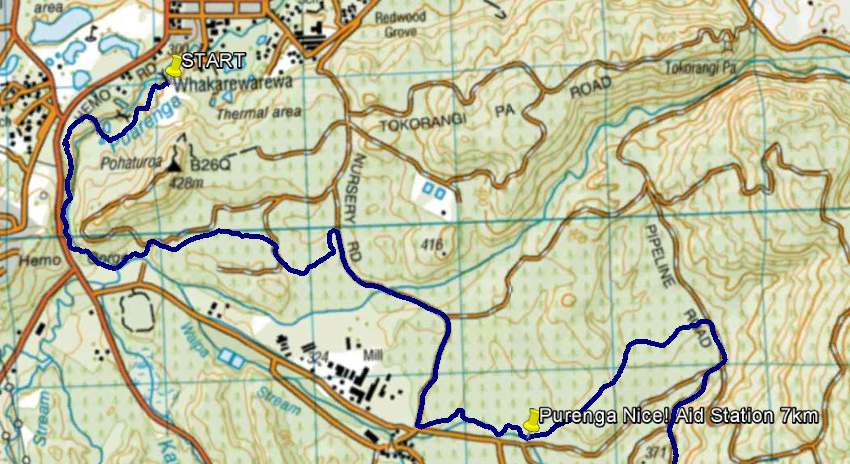
When the race starts jockey but don’t mangle your pace strategy to get track position. DO NOT GO ANAEROBIC TRYING TO GET AROUND PEOPLE. With min 4hrs ahead of you there is plenty of time to pass people.
There is only one tenny-tiny section of up in the 1st 7km and it’s a short set of steps into the Yellow Track prior to Nursery Rd. A gradual climb follows Puarenga/Nice but it is probably runnable for almost everyone.
ENJOY THIS BIT. Puarenga stream is some of the best trail you’ll see. There will be photographers here en mass. SMILE!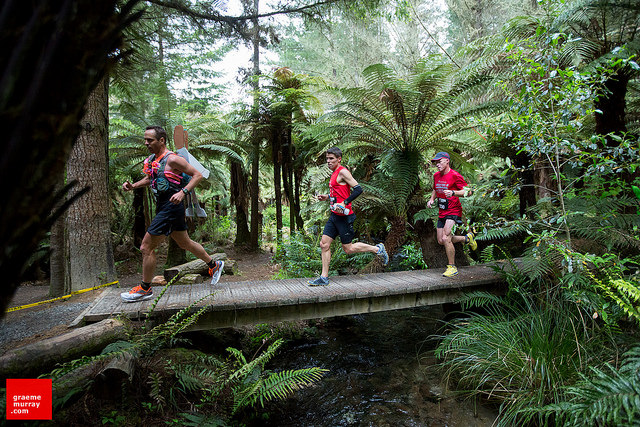
Puarenga Nice (7km) to Green Lake Picnic AS
There are a series of climbs in here that will have you wanting to kick a certain race director in the shins. Remember this when he tries to hug you later that day at the finish line.
Most of these climbs you should walk (/march).
The first climb comes in thick bush after the sequence of forest roads following your departure from Pipeline Rd. It is important to note that the section of forest road at around the 10km mark is very rocky and large stones could easily cause you to roll your ankle even though the track is wide. CONCENTRATE! The descents on this forest road require you to think about your foot placement. This is the ‘choppiest’ bit of ‘road’ you will run and certainly the most danger for your ankles.
The climb in the pines referred to as ‘Tims track’ is short (less than 4min for most). Put your hands on your knees and grind it out. It’s true single track here so once you’ve crested you’ll weave in tight single-file before coming out in a logging skidder pan. Again, it would be easy to roll an ankle in this short section. Concentrate.
The climb to Pondy is a legit ascent. Even the elites will vary between running and walking. Put your hands on your knees and trek this hard. Avoid going anaerobic but let the intensity peak here. You can recover on the forthcoming descent. It’s exposed up to Pondy so you will likely feel the heat of morning at this point. Think about your hydration and fuel. By now something should have gone in and more should soon follow.
Departing Pondy you will descend down to the Green Lake Picnic Aid-Station. A short section of single track preceding GLP AS is difficult to run safely as waist-high fern obscures your footing. Turn your toes out and continue to concentrate on placement. Rule 1 – No Injuries!
Beyond Green Lake Picnic Aid-Station
This Aid station is BOSS. Hit it hard and say thanks to the awesome volunteers that are staffing it.
Somewhere roughly in this area new trickery has been added to the course. This of course is in addition to the trickery that Tim added in 2015 with a rogue set of mossy stairs. Trickery seems to accumulate here in the corner of the Green Lake. You have been warned…
Not long following GreenLake Picnic Aid-Station the course will split for the Marathon and 50km routes. For Marathoners the running here is easy and pretty fast. The track around Green Lake to the turn around is open and affords good running (remember your target race pace). You’ll encounter a couple short sets of stairs on your return to GLP AS but nothing you’ll need to plan for.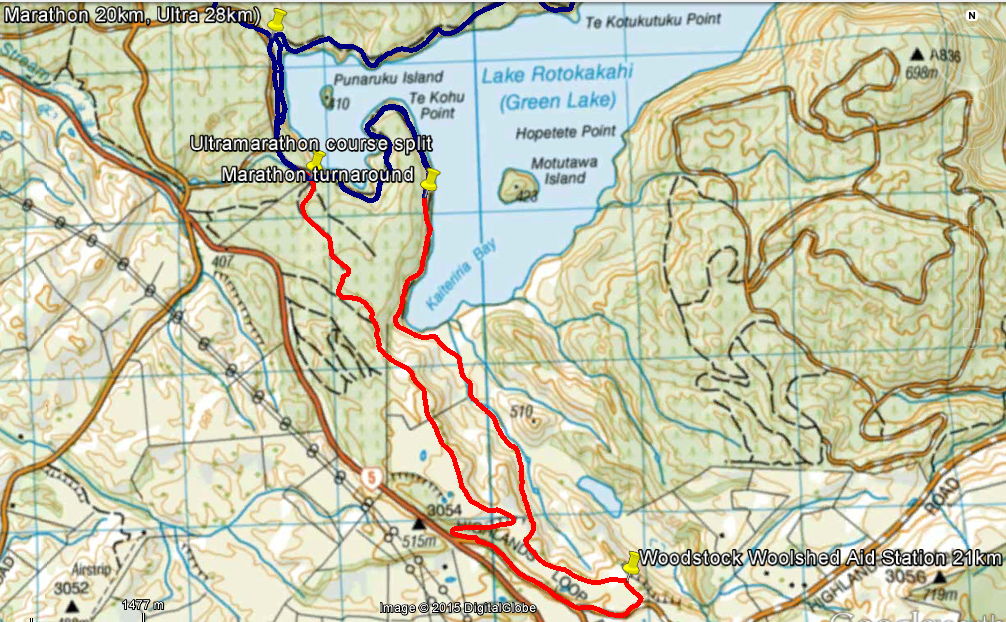
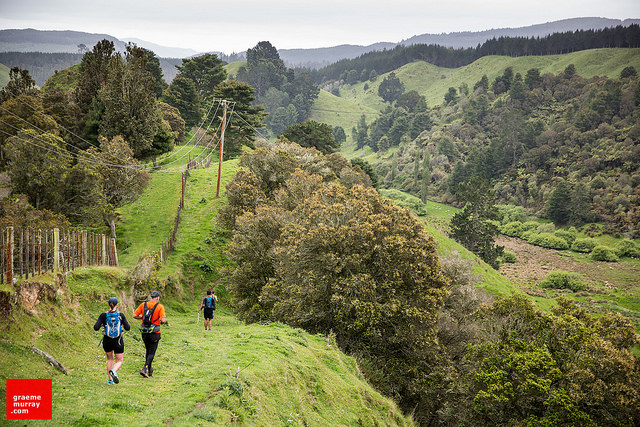 For the 50km-ers, you’re about to get some classic NZ sheep-and-beef countryside. The main climb greets you as you depart the forest for the farmland. It is long and sustained, the difficulty really being that were you fresh and running shorter this climb would be totally runnable. Instead expect to ascend it in a series of walk/jog intervals. Once again, avoiding going anaerobic (>90%maxHR).
For the 50km-ers, you’re about to get some classic NZ sheep-and-beef countryside. The main climb greets you as you depart the forest for the farmland. It is long and sustained, the difficulty really being that were you fresh and running shorter this climb would be totally runnable. Instead expect to ascend it in a series of walk/jog intervals. Once again, avoiding going anaerobic (>90%maxHR).
You lose this height in a pretty steep run down a grassy paddock without the assistance of a ‘groomed’ farm track. Even dry grass can be slippery so be careful not to lean back so far as to arrest your descent and risk a tumble. Where ever possible stay upright and let gravity take you. Don’t resist gravity, use it.
Green Lake Picnic passed Blue Lake and down to Tarawera / Buried Village
After you depart GLP AS for the 2nd time you’ll encounter some of the flatter and more open runnable terrain for the day. Along the northern edge of Green Lake you will find the forest road to wind openly and not change much in elevation. This is a good time to check your pace a bit and passed half way it should start to feel a little challenging to sustain this pace. Fatigue will be setting in a now but that’s by design. Remember your fuel strategy and keep smiling. That view south over the Green Lake is pretty special.
There’s a brief climb up to the Blue Lake but it will pass without effort.
The road section from Blue Lake to Tarawera Car Park is like a free-pass. Don’t hate it because it’s road, embrace it because it’s downhill and so easy to effortlessly run at speed. Think of it as gifted kilometers that will pass with zero suffering. Lean forward and run cleanly. Form really matters now you’re starting to tire.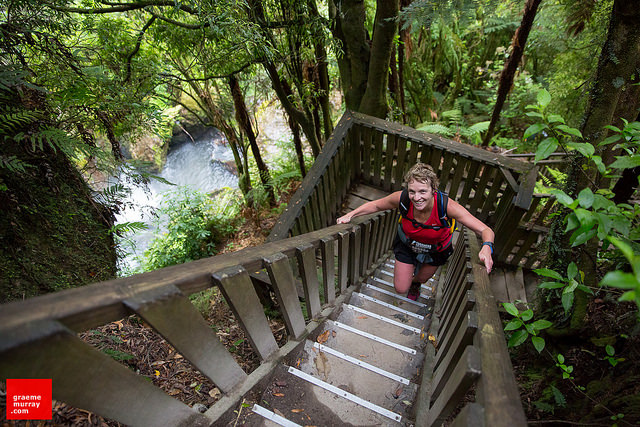
The Buried Village is a twisty little series of trails with a couple of slow sections in tight stairs. It’s more about novelty factor here than actual trail running however it’s a pretty unique experience to be in such a historic location. If a Scone w/ Jam and Cream isn’t on your race plan ignore this and get on with your run. If you came for the full TM50 experience, ‘get amongst it!’
Not the River Crossing
Since there’s 1000 people passing through this section of river it’s likely to cut up rougher than Gordon Ramsey in front of an uncooked chicken breast. So the beautiful handsome and smart race directors have added a temporary bridge of sorts but I suspect no one would be too upset if just a few of you executed a ‘sweet bomb’.
Buried Village to Finish! (last 14km)
The Tarawera Trail is beautiful and there is nothing to worry about underfoot save a few noteworthy climbs that stand between you and the end of your day. Don’t save yourself for them. Even entirely spent you’ll survive the last one. More on that shortly…
After Twin Streams Aid Station you will have a 2-staged ascent, the 2nd climb being the most pronounced. It’s sharp and again you will find yourself forced to a march in places. Keep telling yourself that you are close enough to the finish (within 8km) that you can afford to start going deep. Bite off a gel now, by the time your using it you’ll be into the last climb of your day – Wairua.
Wairua ascent is no joke (unless you’re Craig Kirkwood). You will have already heard about it like it’s the worst thing you could ever come across in a trail run. It’s not that bad! Its less than 200m vertical over 1km of trail. Sharp in places, mainly the first half, it’s only really difficult because by now you’re tired. Hit the first pinches with a little momentum and hike them hard. When you reach the top you wont actually be at the top. You’ll think you are, but you’re not. The trail will continue to gradually roll up and stay high for longer than you really want it to. But by the time you’ve reached this ‘false peak’ the remaining climbing is gradual and runnable.
The 1km of climbing here cannot withstand your relentless assault. Attack it until it yields. No hill is endless and this one is but a pup! GIVE IT HELL!
The final descent is ‘arms-out-aeroplane’ mode. Nrrrroooommmm! Enjoy it. You don’t need your legs anymore and they wont suffer this final km to Tims embrace and a cold beer (or glass of sparkling wine).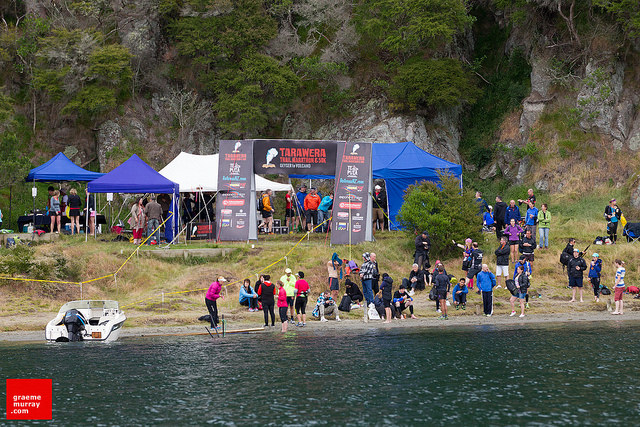
We’ll see you there!



